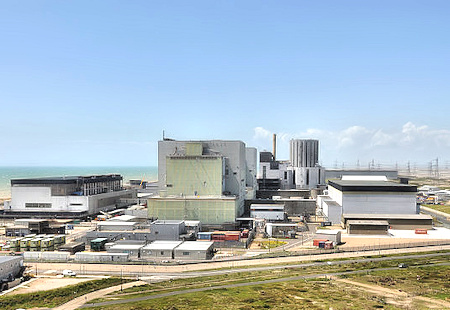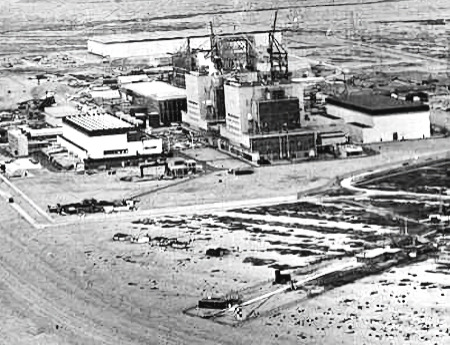Power Stations on Romney Marsh.
Dungeness A is a legacy Magnox power station that was connected to the National Grid in 1965 and has reached the end of its life.
Dungeness B is an advanced gas-cooled reactor (AGR) power station consisting of two 1,496 MWt reactors, which began operation in 1983 and 1985 respectively, and have been non-operational since 2018 due to ongoing safety concerns.
In June 2021 it was decided to move Dungeness B nuclear power station into the defuelling phase.

Dungeness Power Stations

Dungeness A is a legacy Magnox power station that was connected to the National Grid in 1965 and ceased generating power in 2006. It possessed two nuclear reactors producing 219 MW of electricity each, with a total capacity of 438 MW.
The construction was undertaken by a consortium known as the Nuclear Power Group ('TNPG'). The reactors were supplied by TNPG and the turbines by C. A. Parsons & Co. There were originally four × 142.5 MW turbo-alternators, these were later down-rated to 106 MW machines. Steam pressure and temperature at the turbine stop valves was 535 psi (37.6 bar) and 391 °C.
Nuclear fuel for Dungeness power stations can be delivered and removed via a crane loading facility at the end of the nine-mile Appledore-Lydd-Dungeness branch railway. This is connected to the Ashford to Hastings line via an east-facing junction located to the west of Appledore station.
Closure and Decommissioning
On 31 December 2006, the A station ceased power generation. Defuelling was completed in June 2012, and the demolition of the turbine hall was completed in June 2015. It is expected to enter the 'care and maintenance' stage of decommissioning in 2027. Demolition of reactor buildings and final site clearance is planned for 2088 to 2098.

Dungeness Power Station 1968
Dungeness B is one of a fleet of seven Advanced Gas-cooled Reactors (AGR) that, whatever the weather conditions, have reliably provided around 20% of the country’s power supply over the last four decades. Dungeness B started generating in 1983. It was acquired by EDF as part of British Energy in 2009, at which point it was anticipated to end generation in 2018. In 2015 the estimated end of generation was extended to 2028, with a +/- 3 years proviso. Dungeness B has around 500 staff and 250 contractors working on site.
In 2018 the site’s two reactors started a planned period of maintenance, inspections and refuelling. Initial works highlighted problems with the site’s main steam line and corrosion in pipework, both of these were resolved through major investment. EDF also undertook deeper analysis of material conditions within the plant’s boilers, which at Dungeness are contained within the reactors. The investigation found that components, which cannot be replaced, have changed faster than anticipated.
Decisions on end of generation dates for EDF’s nuclear power stations in the UK are independent of the regulator or government and are taken by EDF’s licensee board following recommendations from EDF Energy Nuclear Generation Limited’s Executive. They are then endorsed by relevant senior Boards and, if needed, shareholders. To comply with market regulations, once agreed, any change to forecast generation dates must be promptly published on the REMIT transparency website operated by Elexon, and will be published on EDF’s transparency website.
Defuelling Phase
On 7 June 2021 EDF decided to move Dungeness B nuclear power station in Kent into the defuelling phase with immediate effect.
Since September 2018 the station has been in an extended outage in which EDF has been managing a range of unique, significant and ongoing technical challenges that are not found at the other six AGR power stations. Although many have been overcome, new detailed analysis has further highlighted additional station-specific risks within some key components, including parts within the fuel assemblies.
As a result, EDF has taken a decision not to restart the plant but to move it into the defuelling stage. The final generation of electricity in 2018 means the plant ran for 10 years longer than its original design life, and in line with expectations when it was acquired by EDF in 2009.
Since it came online in 1983, Dungeness B has generated enough low carbon energy to meet the needs of every home in Kent for more than 50 years. The station has also helped the UK avoid the emission of almost 50m tonnes of carbon dioxide and contributed more than £1bn into the Kent economy.
Construction began at Dungeness B in 1967. It was to be the first of a new wave of UK nuclear power stations and has a design not copied anywhere else in the UK fleet. The plant connected to the electricity grid in 1983. The original design life was 2008 and this was extended following investment in the plant at that time and subsequently. In 2016 Dungeness had its best-ever year, generating enough energy to meet the needs of some 2 million homes.
John Benn, Station Director at Dungeness B said: “This power station has been a cornerstone of life in Kent for decades. It is a very special place and the team has a real sense of family – we are part of the community.
“EDF has had to make a hard decision – but it is the right one. It gives our teams, our community and our business a clear understanding of the future.
“I’m enormously proud of everything the team at Dungeness has achieved. Our low-carbon electricity has helped Britain over the past four decades and we have provided this part of Kent with vital jobs for generations. This marks the beginning of the next chapter in this station’s story. We will now plan the defuelling operations, a job we expect will take several years, and one that provides ongoing opportunities for our staff and their specialist skills.”
Defuelling is the first stage of decommissioning a nuclear power station and a process that involves continued use of EDF’s uniquely experienced teams, and specialist supply chain companies, preserving an important source of jobs in Kent and the surrounding area.d were expected to restart in December 2020. On 7 June 2021, EDF announced that Dungeness B would move into the defuelling phase with immediate effect.


